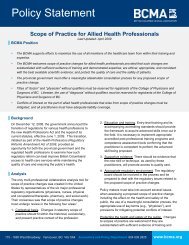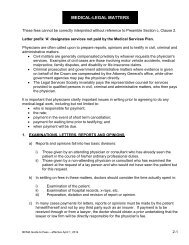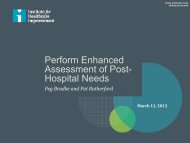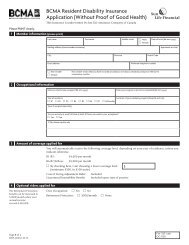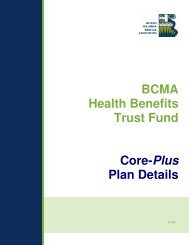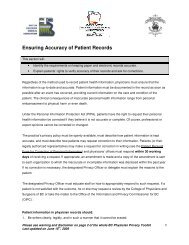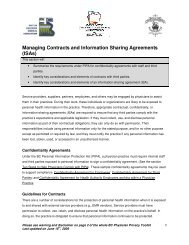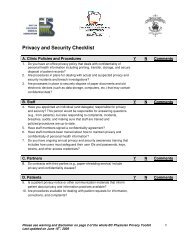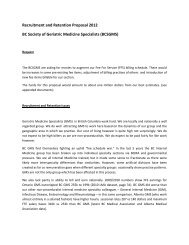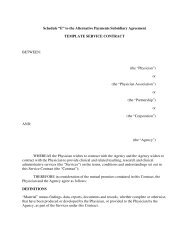Doctors Today and Tomorrow - British Columbia Medical Association
Doctors Today and Tomorrow - British Columbia Medical Association
Doctors Today and Tomorrow - British Columbia Medical Association
You also want an ePaper? Increase the reach of your titles
YUMPU automatically turns print PDFs into web optimized ePapers that Google loves.
Executive Summary<br />
Yogi Berra said it best: “It’s tough to make predictions, especially about the future.” In the realm of physician workforce<br />
planning, the proof of his statement lies in the cycles of shortages <strong>and</strong> surpluses of physicians in <strong>British</strong> <strong>Columbia</strong> over<br />
the years. No one seems able to get the right number, <strong>and</strong> perhaps—absent a crystal ball—no one ever will. It may be<br />
that the challenge of forecasting physician supply—an endeavor that requires consideration of multiple <strong>and</strong> difficultto-measure<br />
variables—just does not lend itself to easy prediction.<br />
However, good policymakers never let perfection be the enemy of the good. And if cycles of surpluses <strong>and</strong> shortages<br />
are an inevitable part of physician workforce planning, our goal should not be a futile effort to eliminate them, but<br />
rather to minimize them as much as possible. The central message of this paper is that the physician workforce<br />
planning process in <strong>British</strong> <strong>Columbia</strong> is too fragmented <strong>and</strong> too short-term in its focus to do so.<br />
The nature of this flawed process is obvious to the multiple stakeholders influencing physician workforce planning,<br />
including the provincial government, health authorities, BCMA, universities, regulatory bodies, <strong>and</strong> medical<br />
community. Too often, each develops <strong>and</strong> implements their policies in isolation. The result compromises <strong>British</strong><br />
<strong>Columbia</strong>ns’ access to timely, high-quality, <strong>and</strong> effective physician services. Moreover, the health care system continues<br />
to face growing pressures from the increasing complexity of patient case-mix, the resulting dem<strong>and</strong> for more physician<br />
time <strong>and</strong> services, the ongoing evolution of the practice of medicine, <strong>and</strong> the changing demographics of the physician<br />
population. Fully 42% of BC’s physicians, for example, are 55 years old or older.<br />
In this paper, the BCMA examines the challenges of physician workforce planning through the lens of the medical<br />
career lifecycle. Each stage—medical student, resident, practicing physician, <strong>and</strong> near-retirement—offers opportunities<br />
for stakeholders to improve current policy <strong>and</strong> underst<strong>and</strong>ing on the individual choices that physicians make about<br />
what, how, <strong>and</strong> where they practice. Doing so will align physician resource planning more closely with the population’s<br />
need for health care services. Some of these can be implemented immediately by the government. For example, an<br />
increase in the number of government-funded residency positions would add greater flexibility in the postgraduate<br />
training system <strong>and</strong> allow opportunities for re-entry <strong>and</strong> enhanced skills training for practicing physicians. Others will<br />
take longer. Among the most significant recommendations of the paper are:<br />
• Establishing a multi-stakeholder provincial committee led by the BCMA, Ministry of Health, <strong>and</strong> the health<br />
authorities to direct <strong>and</strong> coordinate the development of physician resource plans <strong>and</strong> to identify short- <strong>and</strong> longterm<br />
physician resource priorities.<br />
• Developing a provincial analytical framework for needs-based physician resource planning.<br />
• Creating a provincial physician workforce database to form the basis of physician resource planning.<br />
Physician workforce planning is not solely a technical exercise; it is also a value-driven one. The future need of<br />
physicians is influenced by the political <strong>and</strong> social choices that underlie the health care system, <strong>and</strong> how the<br />
future role of the physician is defined. There is no one ideal physician-to-population ratio or optimum number of<br />
physicians – other than the one that fully-informed <strong>British</strong> <strong>Columbia</strong>ns support. By adopting a more collaborative<br />
<strong>and</strong> comprehensive planning approach, both provincially <strong>and</strong> nationally, stakeholders can minimize unintended<br />
policy impacts, the mismatch between supply <strong>and</strong> needs, <strong>and</strong> costly duplication. This common goal should propel all<br />
stakeholders to work together thoughtfully <strong>and</strong> collaboratively to improve physician workforce planning, because what<br />
we prepare for now will be what we get later.<br />
<strong>Doctors</strong> <strong>Today</strong> <strong>and</strong> <strong>Tomorrow</strong> – Executive Summary 1



